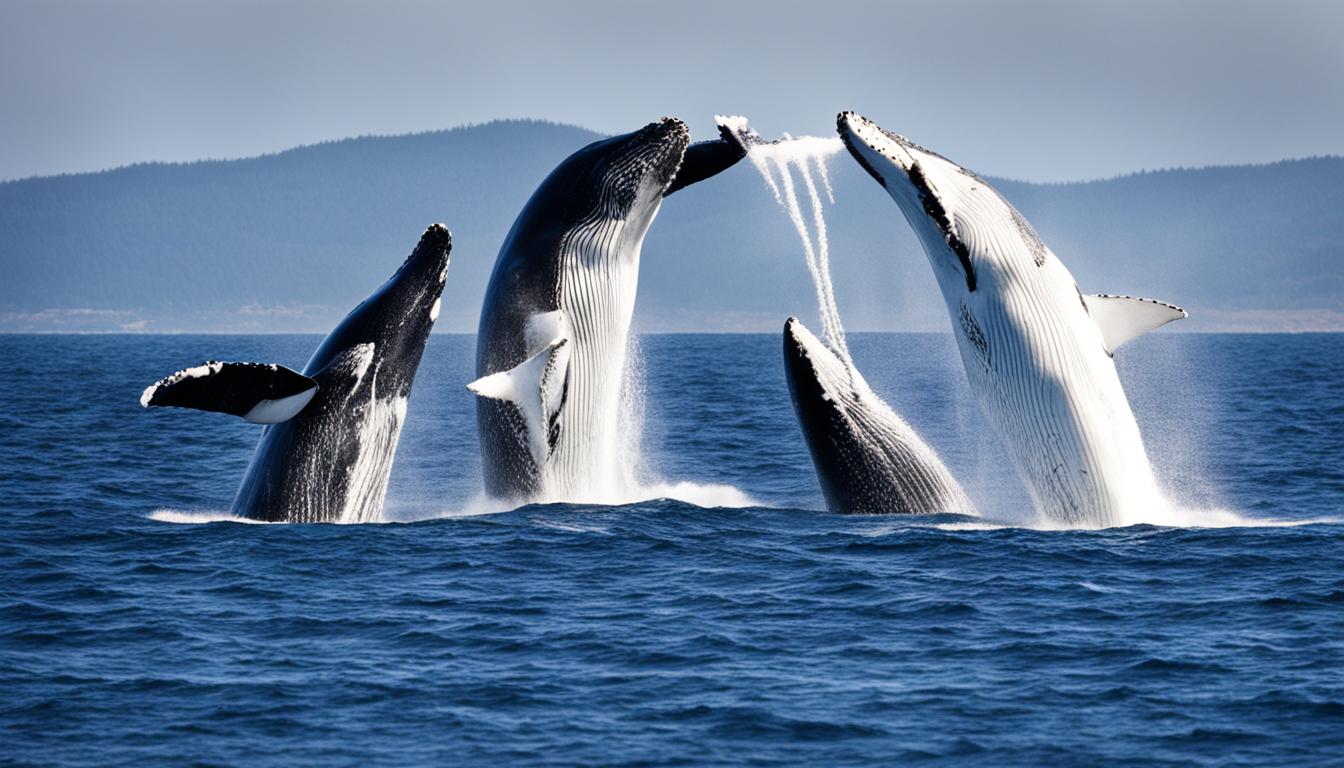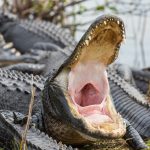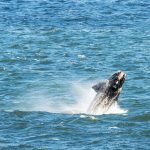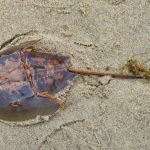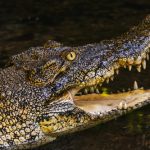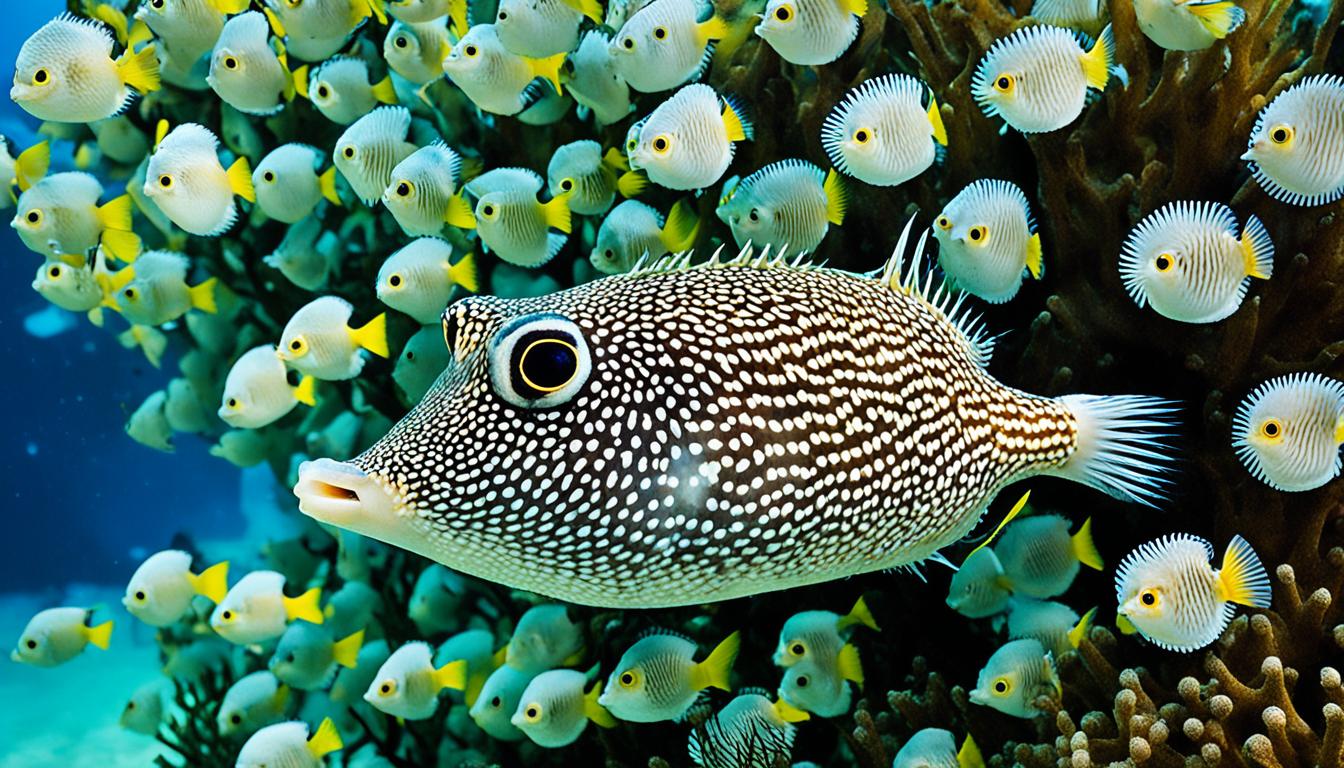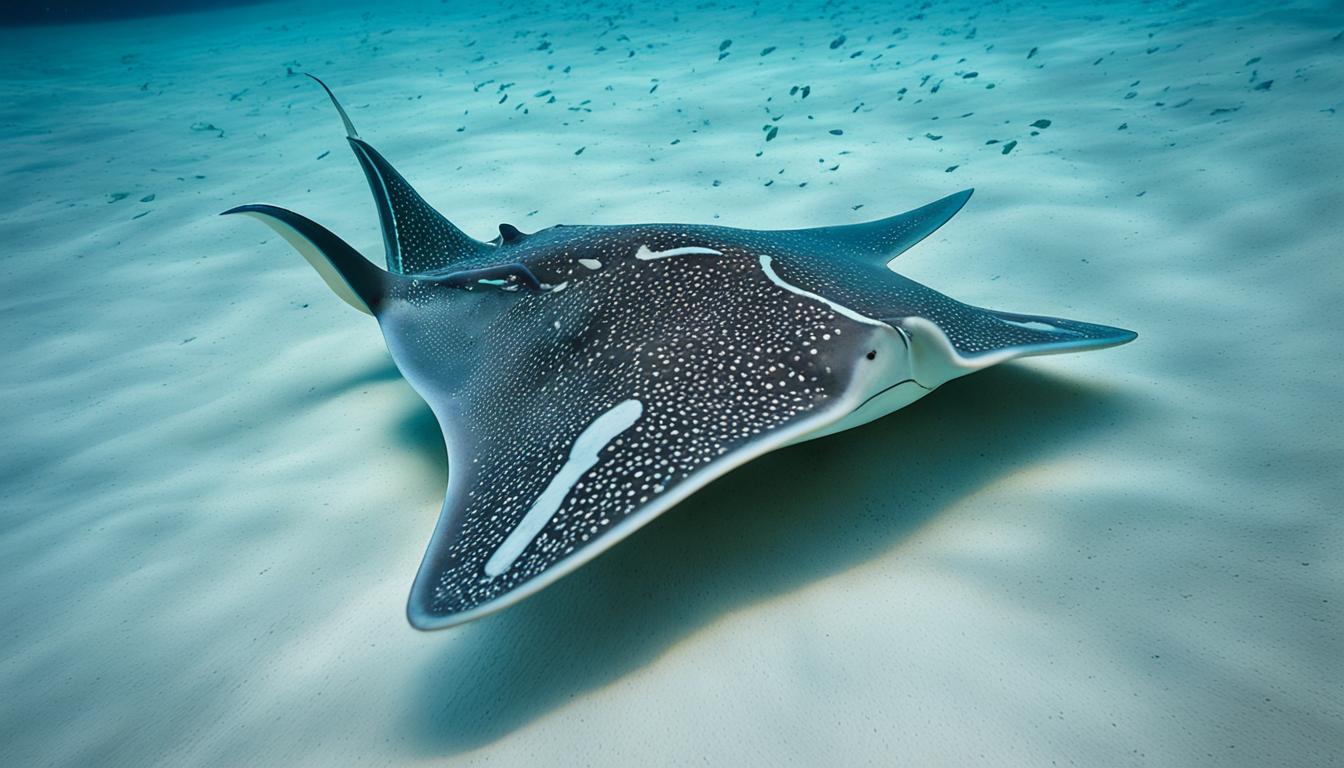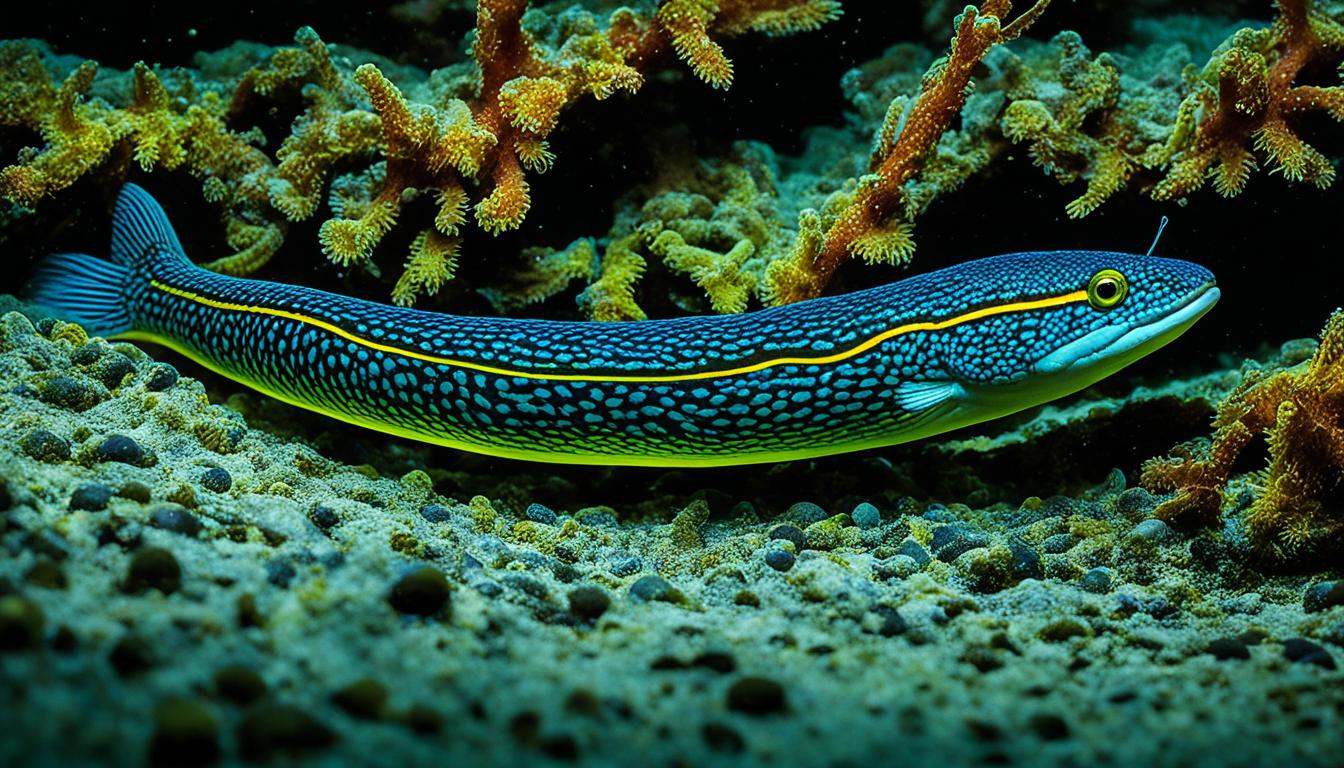Ever wondered how whales get their food? It’s key to understanding the ocean’s balance. Let’s dive into how whales feed and their special ways of finding food. We’ll look at their feeding habits and how they adapt to their ocean home.
Whales have unique ways to eat, which helps us understand their role in the sea. By learning about their feeding habits, we see how they face challenges in their environment. This knowledge is important for protecting these amazing creatures.
Understanding Whale Feeding Habits
Whales have interesting ways of eating, divided into two main groups: baleen whales and toothed whales. These groups show big differences in how they eat and what they like to eat. Knowing these differences helps us understand their roles in nature and how they adapt.
Different Types of Whales: Baleen vs. Toothed
Baleen whales, like the blue and humpback whales, have baleen plates. These plates help them filter feed on small creatures, mostly krill. They can eat a lot of tiny life in the ocean this way.
Toothed whales, such as sperm whales and orcas, hunt actively for bigger sea animals like squid and fish. Their eating habits show big differences in how they live and what they hunt.
The Role of Diet in Whale Behavior
The food a whale eats greatly affects its behavior. For example, baleen whales travel long distances to find food, while toothed whales hunt together in groups. The food they find can change where they go and how they live.
This shows why knowing about their diets is key to protecting these amazing animals.
Methods of Whale Feeding
Whales have amazing ways to find food, using two main methods: filter feeding and active hunting. These strategies help them survive in the ocean. Let’s dive into how they do it.
Filter Feeding: An Overview
Baleen whales use filter feeding to eat. They take in huge amounts of water and use their baleen plates to catch food. In the water full of nutrients, they eat krill and small fish. Then, they push the water out, leaving the food behind.
This way, baleen whales can eat a lot in places with lots of food. It shows how they are adapted to their environment.
Active Hunting in Toothed Whales
Toothed whales, like dolphins and orcas, hunt actively. They use echolocation to find and catch their food. This method sends sound waves that bounce back, telling them about the size and distance of their prey.
This skill is key for their hunting. They can catch fish, squid, and even other whales. Their teamwork during hunts shows how important social behavior is for their hunting success.
| Feeding Method | Species | Key Characteristics | Primary Prey |
|---|---|---|---|
| Filter Feeding | Baleen Whales | Large volume water intake, baleen plates for trapping | Krill, small fish |
| Active Hunting | Toothed Whales | Echolocation, social hunting strategies | Fish, squid, other marine mammals |
How Do Whales Feed?
Whales have amazing ways to catch their food, changing their hunting based on what they eat. These feeding methods show how well they’ve adapted to their ocean homes. The ocean’s changes affect when and how whales hunt, making their feeding patterns interesting.
Feeding Techniques Adapted to Prey
Each type of whale has its own way to catch food. Humpback whales use a bubble-net method to trap fish. They make bubbles around the fish, then swim up to eat. Gray whales, however, eat on the ocean floor, looking for small crustaceans like amphipods.
Seasonal Variations in Whale Feeding
Seasons change how whales hunt for food. They move to places with lots of food as temperatures and nutrients change. In summer, many whales go to cold waters full of food. When winter comes, they head to warmer areas with less food but safer for breeding.
| Whale Species | Feeding Technique | Preferred Prey | Seasonal Feeding Patterns |
|---|---|---|---|
| Humpback Whale | Bubble-net feeding | Small fish (e.g., herring) | Active in summer; migrates in winter |
| Gray Whale | Bottom feeding | Amphipods | Forages in shallow waters; migrates south in winter |
| Blue Whale | Filter feeding | Krill | Feeding peaks in summer; migrates in winter |
Whale Feeding Patterns in Different Species
Whales have different ways of eating that show how they behave and fit into their environments. The humpback whale uses special methods to get as much food as it can. The blue whale, the biggest animal on Earth, eats a certain type of food that shows how varied whale diets are.
Case Study: Humpback Whale Bubble-Net Feeding
Humpback whales are known for their bubble-net feeding. They work together to make a bubble net to catch small fish. After trapping the fish, they jump up to grab their food. This shows how smart and social these whales are.
Blue Whale and Its Krill Diet
Blue whales eat mostly krill, tiny shrimp-like creatures in the ocean. They can eat up to four tons of krill a day during certain times. Their big mouths let them take in lots of water with krill, which they filter out with special plates.
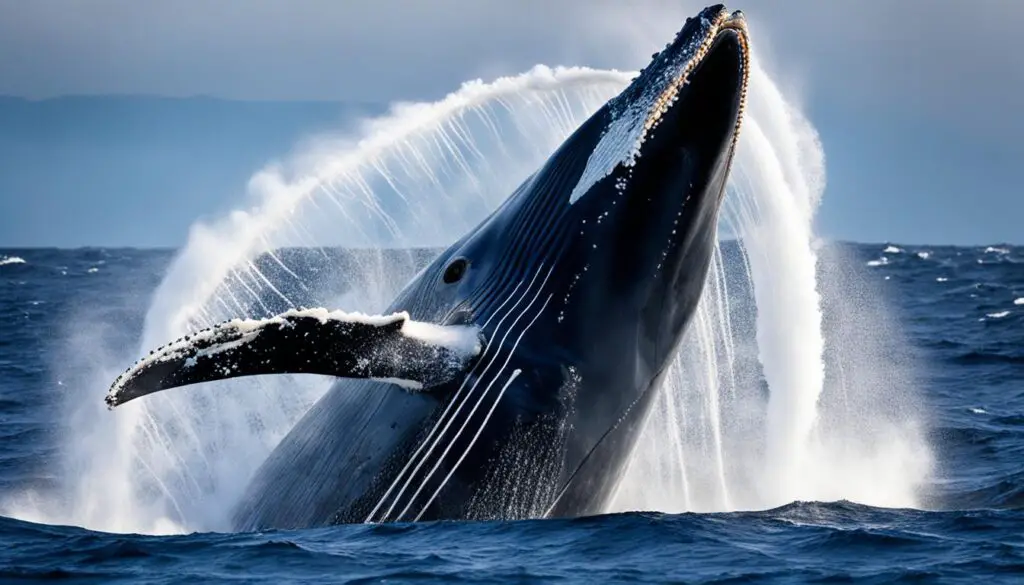
Whale Foraging Techniques
Whales have amazing ways of finding food that show how smart and adaptable they are. Rorquals, like fin and blue whales, use both group and solo hunting strategies. Watching how they eat helps us understand their social lives and how they learn.
Social Feeding Strategies Among Rorquals
Rorquals, including humpbacks and blue whales, often hunt together. They work as a team to herd or trap their food. This teamwork helps them catch more krill and small fish. Some key social hunting methods are:
- Bubble-net Feeding: They make a bubble net to trap fish, making them easy to eat.
- Lunge Feeding: Whales dive and then open their mouths wide to grab a lot of food at once.
- Cooperative Hunting: Whales work together to surround schools of fish, making it hard for them to get away.
Individual Adaptations and Learning Behavior
Learning on your own is also key to a whale’s hunting success. Whales can change their hunting ways based on what they learn and the environment. Here’s how they learn:
- Observation: Young whales watch older ones to learn how to hunt better.
- Trial and Error: Whales try different ways to hunt to see what works best for their prey.
- Memory: They remember where and how they found food before, which helps them hunt better.
These techniques show how whales use teamwork and learning to survive in the ocean. It’s a great example of how complex behaviors help them live in different marine environments.
What Do Whales Eat? A Deep Dive into Diet
Whales have a wide range of diets, shaped by their species and where they live. Their eating habits show how they connect with their environments and adapt over time.
From Krill to Fish: Dietary Preferences Explored
Whales eat everything from tiny krill to big fish and squid. Each whale species has its own food preferences:
- Baleen whales eat mostly small things like krill. They use a special way to catch a lot of food.
- Toothed whales, like orcas and sperm whales, hunt bigger fish and squid. They hunt actively.
These different diets help each whale species survive and reproduce in its own special place.
The Impact of Prey Availability on Migration
The amount of food affects whales’ diets and where they go. Changes in food can make whales:
- Change their migration paths to follow the food.
- Change how they hunt, depending on what food is around.
Knowing how whales eat and how food affects their migration helps us protect them better.
Whale Feeding Ecology and Environmental Impact
Learning about whale feeding habits helps us understand the complex web of life in the ocean. These creatures are key to their ecosystems, affecting the numbers of their prey and keeping the ocean healthy. Their eating habits change the lives of many sea creatures, showing how big an impact whales have on the ocean.
The Role of Whales in Marine Food Chains
Whales are crucial in the ocean’s food chains. They eat a lot of krill and bigger fish, keeping their homes stable. When they poop, they add nutrients to the water that help plants grow. This is key for many sea creatures to survive.
So, whales are important as both predators and food sources. They help keep the ocean healthy.
Impact of Climate Change on Whale Diets
Climate change is changing what whales eat. Changes in the ocean make it harder to find food, so whales have to move or change how they hunt. Watching whales can tell us about the ocean’s health, which is why we need to protect them.
By understanding how whales adapt, we can help protect them and the ocean they live in.

